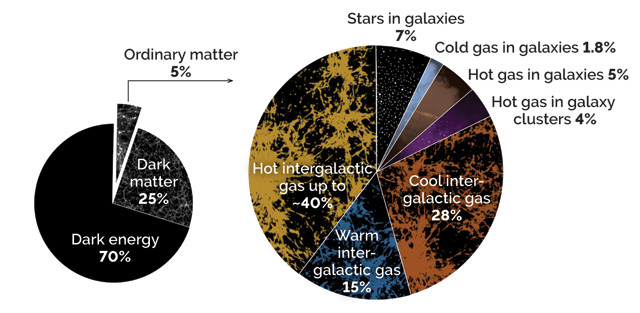
by Mara Johnson-Groh Monday, September 10, 2018

Dark matter and dark energy make up 95 percent of our universe; the remaining 5 percent is made up of ordinary matter called baryons, most of which has remained hidden until recently. Scientists have now discovered much of the intergalactic material that they'd never previously seen. Credit: ESA.
Astronomers recently located half of the ordinary matter in the universe — a detection that has eluded scientists for decades.
Most everything that exists in the universe is either dark matter or mysterious dark energy, which we know little about. The remaining 5 percent is ordinary matter, composed of what are called baryons, a Greek-rooted word meaning “heavy particles.” Baryons make up you, me, the stars, and everything else we see on Earth and in the night sky — and, as we now know, they also make up the recently discovered material thinly dispersed across intergalactic space.
“This is the first time that we detect a large fraction of baryons in the diffuse spaces between galaxies,” says Fabrizio Nicastro, a researcher at the Astronomical Observatory of Rome and Harvard University, and lead author of a new study in Nature announcing the find. “This matter is ultimately the very fuel for the formation of the [galaxies],” he says.
Thirty years ago, scientists began creating models and simulations of the universe. Time and again, these simulations, and more refined ones since, found that the universe should be home to an immense amount of matter not caught up in stars and galaxies. Galaxies themselves are relatively rare, composing only 10 percent of baryonic matter. It is in the vast spaces between galaxies that most of the matter lies hidden. While some of this intergalactic matter has been found in cool and warm gas clumps, a large majority was still missing.
From simulations, it was thought that the missing matter would be extremely hot — as hot as the sun’s outer atmosphere — and very diffuse, with only one atom per cubic meter (by comparison our atmosphere at sea level has more than 250 trillion trillion molecules per cubic meter). The very nature of the hot matter makes it difficult to see; in fact, it’s impossible to see directly. However, Nicastro and his colleagues determined its existence by examining light coming from a distant quasar — a galaxy with an active supermassive black hole — using the XXM-Newton, an X-ray telescope in space. As light from the quasar passes through the universe, regions with hot baryons absorb some of the light, effectively blocking out specific wavelengths and thus leaving their mark on the remaining light from the quasar that we observe.
The researchers studied the quasar, which resides 4 billion light-years away, for 18 days, making it the longest X-ray observation of a quasar to date. The long observations proved successful: Signatures of oxygen, indicating the presence of the baryons, could be seen at two different locations.
“Detecting this matter in the intergalactic space and seeing it through oxygen atoms tells us that the fuel for galaxy formation — gas available to form stars and therefore galaxies — is actually there, and in the amount predicted,” Nicastro says. “Now we can study the entire process and better understand how the universe evolved to its current state, and [how it] will evolve in the future,” he says.
“Recent simulations have shown that WHIM [warm hot intergalactic matter] gas could also be heated by energetic feedback from supermassive black holes in galaxies,” says Romeel Davé, an astrophysicist at the Royal Observatory of the University of Edinburgh in Scotland who was not involved with the study. “Precise measurements of the amount and temperature of WHIM gas could potentially open up a new way to better understand how black holes and galaxies co-evolve.”
The finding also provides additional confirmation for cosmological theories like the Big Bang theory. The measurement of the total amount of baryonic matter in the universe is the first direct confirmation that some of the cosmological parameters in models are correct, bringing us one step closer to understanding our universe, Nicastro says.
While the new findings are significant, the search for baryons is not over, Nicastro says. The scientists plan to continue studying more quasars across the sky to determine if what they found is characteristic of intergalactic space in other parts of the universe or if there is substantial variation. Current instruments are being pushed to their limits for this type of work, but an upcoming European Space Agency mission called Athena, the Advanced Telescope for High-Energy Astrophysics, launching in 2028, will provide higher sensitivity and may help improve such measurements.
© 2008-2021. All rights reserved. Any copying, redistribution or retransmission of any of the contents of this service without the expressed written permission of the American Geosciences Institute is expressly prohibited. Click here for all copyright requests.